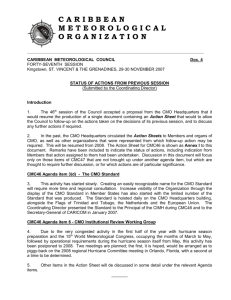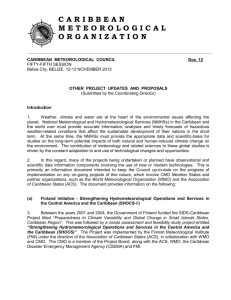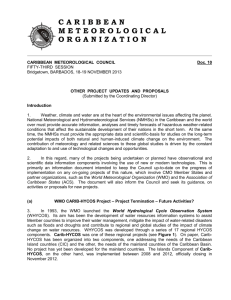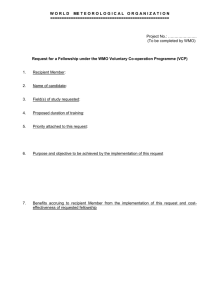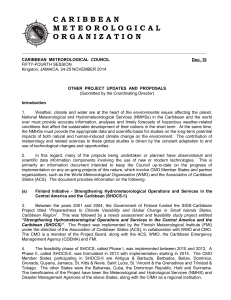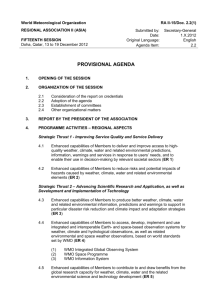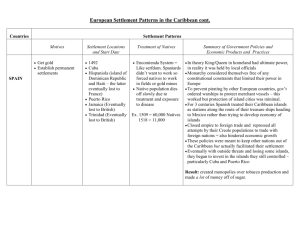CMC54 Doc 3(a) - Caribbean Meteorological Organization
advertisement
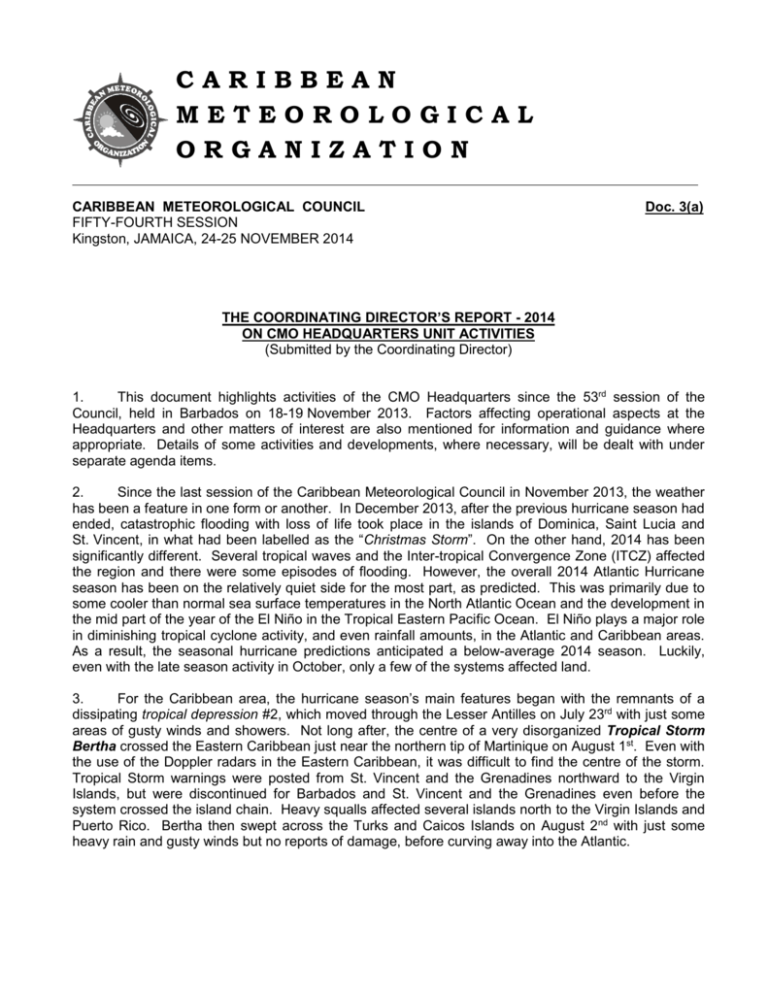
CARIBBEAN METEOROLOGICAL ORGANIZATION CARIBBEAN METEOROLOGICAL COUNCIL FIFTY-FOURTH SESSION Kingston, JAMAICA, 24-25 NOVEMBER 2014 Doc. 3(a) THE COORDINATING DIRECTOR’S REPORT - 2014 ON CMO HEADQUARTERS UNIT ACTIVITIES (Submitted by the Coordinating Director) 1. This document highlights activities of the CMO Headquarters since the 53rd session of the Council, held in Barbados on 18-19 November 2013. Factors affecting operational aspects at the Headquarters and other matters of interest are also mentioned for information and guidance where appropriate. Details of some activities and developments, where necessary, will be dealt with under separate agenda items. 2. Since the last session of the Caribbean Meteorological Council in November 2013, the weather has been a feature in one form or another. In December 2013, after the previous hurricane season had ended, catastrophic flooding with loss of life took place in the islands of Dominica, Saint Lucia and St. Vincent, in what had been labelled as the “Christmas Storm”. On the other hand, 2014 has been significantly different. Several tropical waves and the Inter-tropical Convergence Zone (ITCZ) affected the region and there were some episodes of flooding. However, the overall 2014 Atlantic Hurricane season has been on the relatively quiet side for the most part, as predicted. This was primarily due to some cooler than normal sea surface temperatures in the North Atlantic Ocean and the development in the mid part of the year of the El Niño in the Tropical Eastern Pacific Ocean. El Niño plays a major role in diminishing tropical cyclone activity, and even rainfall amounts, in the Atlantic and Caribbean areas. As a result, the seasonal hurricane predictions anticipated a below-average 2014 season. Luckily, even with the late season activity in October, only a few of the systems affected land. 3. For the Caribbean area, the hurricane season’s main features began with the remnants of a dissipating tropical depression #2, which moved through the Lesser Antilles on July 23rd with just some areas of gusty winds and showers. Not long after, the centre of a very disorganized Tropical Storm Bertha crossed the Eastern Caribbean just near the northern tip of Martinique on August 1st. Even with the use of the Doppler radars in the Eastern Caribbean, it was difficult to find the centre of the storm. Tropical Storm warnings were posted from St. Vincent and the Grenadines northward to the Virgin Islands, but were discontinued for Barbados and St. Vincent and the Grenadines even before the system crossed the island chain. Heavy squalls affected several islands north to the Virgin Islands and Puerto Rico. Bertha then swept across the Turks and Caicos Islands on August 2nd with just some heavy rain and gusty winds but no reports of damage, before curving away into the Atlantic. CMC54, Doc 3(a), page 2 4. The Turks and Caicos Islands were again the target of severe weather as, on August 23rd, a tropical depression formed right over the Archipelago, strengthening to Tropical Storm Cristobal near the Eastern Bahamas on August 24th. The Turks and Caicos Islands experienced heavy rains, gusty winds and extensive flooding in low lying areas, especially on the islands of Middle and North Caicos. International and domestic air travel was suspended for a while. Cristobal then moved northwards, strengthening to a hurricane before passing to the west of Bermuda, then racing away over the open ocean. Surf, swells and dangerous rip current generated by Cristobal affected Bermuda and portions of the US east coast. 5. In mid-September, Hurricane Edouard formed. It became the first of only two major hurricanes to form in 2014, but remained entirely over the Atlantic Ocean, with no threat to land. On October 10th, Tropical Storm Fay formed south-east of Bermuda. From the evening of Saturday October 11th into Sunday 12th, tropical storm force winds, heavy rains and large sea swells affected Bermuda as Fay’s centre passed right over the island causing fallen trees and power outages. Fay then moved rapidly away from Bermuda, briefly reaching Hurricane Fay before weakening. 6. Virtually at the same time, on October 12th, Tropical Storm Gonzalo formed east of the Leeward Islands, moving over Antigua and Barbuda and the Virgin Islands with tropical storm winds and heavy rains on October 13th. Gonzalo strengthened rapidly to become a hurricane while moving through the Northern Leeward Islands, passing near Anguilla and St. Maarten with the eye passing just northeast of the British Virgin Islands on October 14th, then becoming a major category 3 hurricane as it moved over open water. Hurricane Gonzalo injured about 12 persons in Antigua and killed one person on a boat in St. Maarten. Surf and large swells affected the Leeward and Virgin Islands, as well as portions of the Turks and Caicos Islands. Bermuda was again the target of this hurricane as the centre raced directly over the island archipelago with category 2 winds up to 115 mph (185 km/h), damaging waves and surf. More than a week of warnings minimized casualties as only minor injuries were reported, but the hurricane caused Radar composite – Hurricane Gonzalo, Oct 13. power outages to over 30,000 homes, Courtesy Météo-France produced flooding, felled trees and damage to buildings. 7. Late in October, tropical depression #9 formed in the Bay of Campeche in the Gulf of Mexico. This depression moved towards the east, instead of the normal west, crossed the Yucatan Peninsula, producing some heavy rains, including across parts of Belize, before entering the Caribbean Sea. It eventually drifted to just off the Nicaraguan coast where, on October 27th, it reorganized itself just enough to be named as Tropical Storm Hanna. It then quickly moved inland near to the Nicaragua-Honduras border, producing very heavy rainfall, flash flooding and mud slides. CMC54, Doc 3(a), page 3 8. A summary map, prepared at the end of October 2014, is shown in ANNEX I. The season produced 8 named storms, which included 6 hurricanes, two of which became major hurricanes, as compared to the long-term seasonal averages of 12 named storms, with 6 hurricanes and 3 major hurricanes. It is instructive to note the complete opposite hurricane situation in 2014 in the Eastern North Pacific Basin in which, by November 3rd, there were 20 named tropical cyclones, of which 14 became hurricanes. Throughout the Hurricane season, the CMO Headquarters routinely monitors the effectiveness of the regional warning system, including the timeliness and content of the various warnings issued by the National Meteorological and Hydrometeorological Services (NMHS) in Member States. Before the start of the 2014 hurricane season, the CMO Headquarters organized a visit to St. Vincent and the Grenadines by one of the hurricane reconnaissance aircraft, known as a “Hurricane Hunter”, operated by the United States Air Force Reserves. This was part of the annual Caribbean Hurricane Awareness Tour (CHAT), operated by the USAF and the US National Oceanic and Atmospheric Administration (NOAA). CMO is considering a similar tour to St. Kitts in 2015. 9. Many of the activities of the CMO Headquarters in 2014 were aimed at regional implementation of many global programmes and initiatives, particularly those set in motion by the World Meteorological Organization as they relate to the Caribbean region in general and CMO Member States in particular. WMO is the specialized agency of the United Nations that sets out the policies and programmes that impact on matters relating to weather, climate and water in every country of the world, whether large or small, developed or developing. It is a well-recognized fact that many small States have difficulties in keeping up with the many scientific and technological advances that take place globally, but which nonetheless affect all countries. It has therefore always been imperative for the Caribbean Meteorological Organization, as one of the pillars of its mandate, to actively participate in WMO activities at the highest possible level in order to ensure that the interests of small developing states are accounted for and to guide and advise the CMO Member States in their own related activities. For this reason, the Coordinating Director, as an elected member of the WMO Executive Council since 1999, maintains a strong and experienced team of senior Advisors and Experts that individually and collectively have become very involved in WMO’s programmes and activities. The Coordinating Director, as the Permanent Representative of the British Caribbean Territories with WMO, also ensures the participation of relevant experts in the technical work of the WMO for the benefit of the entire CMO Membership. A list of these experts and their roles is shown in ANNEX II. 10. Specifics of the implementation of WMO Programmes that impact on the CMO Member States are discussed under various agenda items. However, it is necessary to highlight to the Council the progress being made in a few key activities. 11. Over the last few years, perhaps the most pressing issue that the Council has been monitoring and emphasizing has been the region’s move to implement a Quality Management System (QMS) for aeronautical meteorological services. The International Civil Aviation Organization (ICAO) has had mandated that these services must be compliant to the 9001:2008 standards set by the International Organization for Standardization (ISO). The WMO and the ICAO have been collaborating to ensure that NMHS all over the world are equipped to meet the requirements. The CMO Headquarters and the Caribbean Institute for Meteorology and Hydrology (CIMH) have been assisting the NMHS of CMO Member States in this matter. CMC54, Doc 3(a), page 4 12. In this regard, some of the NMHSs are QMS-ready but the certification process is still to be completed. Because of the high importance of this matter, the CMO Headquarters and the CIMH participated in a Conjoint Meeting between ICAO and the WMO Commission for Aeronautical Meteorology (CAeM), in Montreal in July 2014. A major revelation during the conjoint session was the news that ISO will be changing its QMS standard from 9001:2008 to a new standard 9001:2015 effective in September 2015, which will be significantly different from the old standard, under which the NMHSs have been working towards their QMS. In addition, the CMO Headquarters has already alerted the Member States to ICAO’s decision to implement a new System Wide Information Management (SWIM) that will have major implications for the provision of meteorological services to the aviation community. Greater detail on both of these matters can be found under Agenda item 5. 13. Cooperation among regional institutions with common interests has been among the activities of the Headquarters in 2014. The focus in some cases was the many aspects of risk reduction, including the prevention and management of disaster risks in the Caribbean Basin and beyond. The CMO was among relevant institutions collaborating with the Carib-Risk Cluster Project, established in 2011 by the General Council of Martinique and co-financed by the European Union. The CMO has also been collaborating with the Association of Caribbean States (ACS) in a project called “Mesoamerican Territorial Information System” (SMIT), which aims to provide a harmonized regional platform with information about threats and vulnerabilities, to strengthen the capacities of national institutions for disaster risk management. Belize is one of the Mesoamerican countries. SMIT is closely aligned to the regional component of the UN initiative on Global Geospatial Information Management (UN-GGIM), designed to strengthen the generation, use and sharing of geospatial information and in which several CMO Member States are expected to be involved. The CMO Headquarters has also been assisting the WMO in developing the weather and climate components of a Regional Platform for Disaster Risk Reduction of the Americas. The regional platforms will serve as inputs to the Third United Nations World Conference on Disaster Risk Reduction (WCDRR), to take place in Japan in 2015. WCDRR will produce a post-2015 framework for disaster risk reduction around the world. 14. In July 2014, the Heads of Government of the Caribbean Community approved a Five-Year Strategic Plan for the Caribbean Community 2015-2019 “Repositioning CARICOM”. The Heads of Government also approved eleven top priorities for focused attention and implementation over the period, given the limited human and financial resources available across the Community. An outline of the Plan and the priority focus areas are provided in ANNEX III to this document. The Coordinating Director and the Principal of the CIMH took part in an September 2014 meeting of the Secretary General of CARICOM and the Heads of Community Institutions to focus on preparing an agreed Framework and Implementation Plan to accompany the Strategic Plan. 15. In this regard, work among the Community Institutions and the CARICOM Secretariat was being organized through clusters of institutions with areas of common interests or activities. The Community institutions and clusters have been asked to articulate the outcomes or expected results on what is achievable in the next five years. A major challenge for the Institutions will be to link their own Strategic Plans and/or Work Programmes with those of this new draft Community Strategic Implementation Plan. In the process, the Institutions felt that a revitalized involvement or re-engagement of the CARICOM Secretariat in the activities of the Community Institutions was essential. There has also been a call for the Community Institutions to do some “rebranding” to clearly identify them as being part of the Caribbean Community. As a result, the CMO Headquarters has modified its letterhead and will reflect this on its Website, which is due for a major upgrade in 2015. CMC54, Doc 3(a), page 5 16. Several of the other activities that have engaged the CMO Headquarters since the Council’s last session have been a continuation from the previous year. Council will note that the development of the new and very important international initiative called the Global Framework for Climate Services (GFCS) was progressing at an excellent pace globally. The GFCS is a global partnership of governments and organizations, led by the WMO, to improve the production and use of climate information and services. It seeks to enable researchers, producers and users of climate information to join forces to improve the quality and quantity of climate services worldwide, particularly in developing countries. The Programme for implementing the GFCS at regional and national scales aims to enhance resilience in social, economic and environmental systems to climate variability and change. This Programme, funded by Canada, will implement the GFCS in the Caribbean, Pacific, South Asia and the Arctic. The major contribution by the CMO will be made by the CIMH, which is currently going through a demonstration phase in preparation for designation as a WMO Regional Climate Centre (RCC) for the Caribbean. Even during this demonstration phase, the CIMH has begun providing services and guidance to CMO Member States to contribute to the implementation of the GFCS. Details will be provided under Agenda Items 3(b) and 5. 17. In 2014, the CMO Headquarters continued to provide technical advice to St. Vincent and the Grenadines in relation to flight operations and future meteorological services at the new international airport being constructed at Argyle on the southeast coast of St. Vincent. This activity is expected to continue throughout the construction phase and beyond. 18. Council will be pleased to note that, in the latter part of the year, there was a comparatively better level of financial contributions from Member States than at the same time in 2013. Details will be discussed under Agenda item 6(c). However, the pressure on Headquarters operations continued for much of the year until the status of the building occupied by the CMO Headquarters in Port of Spain was settled. The Council is aware that, for a number of years, the CMO Headquarters budget had to pay for the rent of the premises it occupies in Port of Spain while the Government of Trinidad and Tobago worked towards resolving the situation with respect to the lease on the property and thus the payment of this rent, in accordance with the Host Country Agreement on the CMO Headquarters. The Council will be pleased to know that the Government and the Landlord signed a lease agreement in June 2014. The CMO Headquarters continued to pay the rent until all budgetary arrangements were in place, after which refunds to the CMO were made. The CMO Headquarters is grateful to the Government of Trinidad and Tobago for concluding the agreement. It is now anticipated that several activities held in abeyance due to the payment of rent will now be carried out in 2015. 19. ANNEX IV to this document indicates meetings and other events attended (or scheduled attendance) by officers of the CMO Headquarters in 2014. This schedule of activities undertaken by the CMO Headquarters to date was a bit heavy, particularly in a year before a Congress of the WMO, because all programs at regional and international levels had to be ready for presentation to the Congress in 2015. However, a number of the activities were financed in whole or in part by partners, thus alleviating potential financial difficulties for the Organization due to the level of contributions by Member States. As will be discussed in detail under Agenda Item 6, the very late receipt of contributions by the Organization from Member States continues to plague the operations of the organs of the CMO. Without the financial support of the Member States themselves, it is almost impossible for a small organization to meet the requirements of Member States and to undertake several activities approved by Council for the benefit of the region. The CMO Headquarters routinely has to “piggy-back” on events organized by others to carry out some CMO activities. 20. The Council should note that the Coordinating Director’s current contract ends in April 2015. As required, the Council is requested to approve the renewal of contract and authorize the Secretary General of CARICOM to issue the new contract under the normal conditions for the post. CMC54, Doc 3(a), page 6 21. The CMO Headquarters continues to promote the participation in as many scientific, technical and training events as possible by the National Meteorological and Hydrometeorological Services and the CIMH, particularly those sponsored by the WMO and its partners that have a special relevance to the region. Most of the relevant international activities in 2014 were focussed on WMO activities, particularly the WMO Technical Commissions. The list below shows the events that the Coordinating Director was able to facilitate in 2014. (i) WMO RA IV Workshop on Hurricane Forecasting and Warning and Public Weather Services, Miami, Florida, USA, March 10-21 [Gerard Tamar, Grenada] (ii) International Conference Workshop on Promoting Weather and Climate Information for Agriculture and Food Security, Antalya, Turkey, April 7-9 in conjunction with WMO Commission for Agricultural Meteorology (CAgM), 16th session, Antalya, Turkey, April 10-15 [Adrian Trotman & Shontelle Stoute, CIMH] (iii) (iv) International Training Course on Aeronautical Meteorology Services, Beijing, China, June 16-27 [Lawrence Pologne, CIMH] (v) WMO Technical Conference on "Climate Services - Building on CLIPS Legacy'', Heidelberg, Germany, June 30-July 2 in conjunction with WMO Commission for Climatology, 16th Session, Heidelberg, Germany, July 3-8 [Adrian Trotman, CIMH] (vi) (vii) WMO Commission for Instruments and Methods of Observation, 16th Session (CIMO-XVI), Saint Petersburg, Russian Federation, July 10-16 [Damien Prescod, CIMH] (viii) CIMH Instrument Maintenance and Calibration Course, Barbados August 18 – September 12 [Phillip Gumbs, Anguilla, Peter Providence, St. Vincent and the Grenadines] (ix) International Training Course on Climate Monitoring, Prediction and Application, Beijing, China, October 20-31 [Shontelle Stoute, CIMH] (x) Third WMO Gender Conference, “Gender Dimension of Weather and Climate Services: The Benefits of Working Together,” Geneva, Switzerland, November 5-7 [Margarette Mayers-Als, CIMH] - - - - - - - - - - - - - - - - - - - - - - - - - - - - - - - - - - - - - - - - - - - - - - - - - - - - - - - - - - - - -- - - - - - - - (xi) WMO Eighth International Workshop on Tropical Cyclones (IWTC-VIII) Dec 2-6, and the (Third International Workshop on Tropical Cyclone Landfall Processes), December 8-10 Jeju, Republic of Korea Researchers: Lawrence Pologne & Ashford Reyes (CIMH) Operational Meteorologists: Ronald Gordon (Belize) & Sabu Best (Barbados) WMO – CIMO/WIGOS Exploratory Workshop: Improving Surface-based Data Quality through Improved Standardization of Procedures, Langen, Germany, December 3-5 [Damien Prescod, CIMH] - - - - - - - - - - - - - - - - - - - - - - - - - - - - - - - - - - - - - - - - - - - - - - - - - - - - - - - - - - - - -- - - - - - - - (xii) CMC54, Doc 3(a), page 7 22. On current staff matters, Council will recall that in 2011, the Administrative Officer, Miss Lynn Nimblett, retired from the Headquarters after forty years of service to the Organization. The Council will also recall that, as permitted by those Rules and Regulations, Miss Nimblett was retained under contract for a period of three years from November 2011 to enable the Headquarters to adequately plan its future changes in financial management and administration. Miss Nimblett has served with all the Coordinating Directors from the inception of the Organization. She started as a Clerk Stenographer II and became a Stenographer III in 1984. In 1992, she was promoted to the position of Executive Secretary; then in 1994, her duties were increased to include those of the Accountant. In 2003, Miss Nimblett was promoted to her present position of Administrative Officer. It is not difficult to realize the institutional memory that will be lost and hard to replace. The Council may wish to join the Coordinating Director and all staff at the CMO Headquarters in thanking Miss Nimblett for her outstanding dedicated service to the Organization for such a long period, and to wish her every success in the future. 23. The CMO, as an Organization, comprises 16 Member States. The Directors/Heads of Meteorological and Hydrometeorological Services are the primary points of contacts for Member States with the organs of the CMO (Headquarters & CIMH). Their contribution to their Services and to meteorology and hydrology at the regional and international levels is therefore well known within the CMO. In this regard, the CMO salutes Mr Fred Rudolf Sambula, Director General of the National Weather Service of the Cayman Islands, who retired in May 2014. 24. Mr Sambula graduated in 1973 with an Associate Degree in Mathematics and Physics in his native Belize, after which he worked with the Hydrometeorological Service of Belize. In 1977, he attended the UK Meteorological College for forecaster training before returning to Belize. In 1981, he migrated to the Cayman Islands where he met and married his wife Annice. He worked with the Civil Aviation Department and developed the Cayman Islands Weather Service, becoming its first Director General. Mr Sambula received advanced training in a number of areas, and also received an MSc degree in Human Resource Management from the University of Portsmouth, UK in 2004. He is a Fellow of the Royal Meteorological Society, UK. Within the Caribbean meteorological fraternity, he is known as the only senior meteorologist who escaped the grasp of the CIMH/UWI system. 25. Mr Sambula was very active on the international level as part of the team led by the Coordinating Director of the CMO, Mr Tyrone Sutherland. He served as the Principal Advisor to the Coordinating Director in sessions of the WMO Executive Council in Geneva, Switzerland; was an active member of the regional Hurricane Committee and represented the region in WMO Technical Commissions in South Korea, China and Croatia. In this role, he gained the respect and admiration of professional colleagues the world over for his contribution and friendly personality. During his tenure at the Cayman Islands Weather Service, he acted for a period in 2008 as the CEO of the Cayman Islands Airports Authority. He will be missed by the CMO Headquarters and the rest of the region. CMC54, Doc 3(a), page 8 Action Proposed to Council: 26. The Council is invited to: (a) Note the activities and issues concerning the CMO Headquarters in 2014, particularly those dealing with the implementation of major WMO and ICAO-related activities, and issues concerning the wider Caribbean Community; (b) Note the resolution of the CMO Headquarters building lease and the continuing impact of deficit contributions by Member States to the Organization on the operations of the headquarters; (c) Note and commend the outstanding contributions to the CMO of Miss Lynn Nimblett of the CMO Headquarters and to the regional and international meteorological community by Mr Fred Sambula of the Cayman Islands. (d) Approve the renewal of the Coordinating Director’s contract and authorize the Secretary General of CARICOM to issue the new contract under the normal conditions for the post. _________ CMO Headquarters November 2014 CMC54, Doc 3(a), ANNEX I 2014 SUMMARY TABLE (TO NOVEMBER 3) Name Dates H ARTHUR 1-5 JULY 100 H BERTHA 1-6 AUG 80 H CRISTOBAL 23-29 AUG 85 TS DOLLY 1-3 SEPT 50 MH EDOUARD 11-19 SEPT 115 H FAY 10-13 OCT 75 MH GONZALO 12-19 OCT 115 TS HANNA 22-26 OCT 40 Figure 1: 2014 Tropical Storms and Hurricane tracks in the Atlantic-Caribbean basin – to the end of October (courtesy NOAA/NHC) Max Wind (mph) CMC54, Doc 3(a), ANNEX II, page 1 British Caribbean Territories (BCT), WMO Regional Association IV EXPERTS Serving WMO Bodies: Permanent Representative (PR): Mr Tyrone Sutherland, Coordinating Director, CMO Hydrological Advisor to the PR: Dr David Farrell, Principal, CIMH List of BCT Experts serving on WMO Technical Commissions and BCT Focal Points WMO Commission for Basic Systems (CBS) Mr Tyrone Sutherland, CMOHQ Mr Glendell De Souza, CMOHQ Mr Lawrence Polonge, CIMH Mr Marvin Forde, CIMH [Mr Fred Sambula, Cayman Islands – until mid-2014] CBS Expert Bodies and Focal Points: BCT Focal Point on Public Weather Services Mr John Tibbetts, Cayman Islands BCT Focal Point for Codes and Data Representation Matters Mr Glendell De Souza, CMOHQ BCT Focal Point for Weather Radar Metadata (FP WR): Mr Glendell De Souza, CMOHQ BCT Focal Point on the WMO Information System (WIS) Mr Kerry Powery, Cayman Islands Other CBS WIS-related Focal Points within the BCT: [Oct 2014] Centre Focal Point for WIS matters Mr Allan Ebanks, Cayman Islands GTS Focal Point Mr Glendell De Souza, CMOHQ RTH Focal Point Mr Glendell De Souza, CMOHQ Focal Point for WIS Discovery Metadata matters Mr Avalon Porter, Cayman Islands Commission for Instruments and Methods of Observation (CIMO) Mr Tyrone Sutherland, CMOHQ Mr Marvin Forde, CIMH Mr Damien Prescod, CIMH CIMO Expert Bodies and Focal Points: BCT member of the CIMO Expert Team on Operational Metrology Mr Damien Prescod, CIMH CMC54, Doc 3(a), ANNEX II, page 2 Commission for Atmospheric Sciences (CAS) [Mr Fred Sambula, Cayman Islands – until mid-2014] Dr Andrea Sealy, CIMH Mr Lawrence Polonge, CIMH CAS Expert Bodies and Focal Points: BCT Focal Point for the World Weather Research Programme Dr Andrea Sealy, CIMH Commission for Aeronautical Meteorology (CAeM) Mr Glendell De Souza, CMOHQ [Mr Fred Sambula, Cayman Islands – until mid-2014] Ms Kathy-Ann Caesar, CIMH Mrs Margarette Mayers-Als, CIMH CAeM Expert Bodies and Focal Points: Expert Team for Education, Training and Competencies (ET-ETC – WG3) Ms Kathy-Ann Caesar, CIMH Commission for Agricultural Meteorology (CAgM) Mr Adrian Trotman, CIMH Mr Anthony Moore, CIMH CAgM Expert Bodies and Focal Points: OPAG 1 – Agrometeorological Services for Agricultural Production Expert Team (ET) on Strengthening Operational Mr Adrian Trotman, CIMH, Expert for Agrometeorological Services (ETSOAS) RA IV Joint WMO/IOC Technical Commission for Oceanography and Marine Meteorology (JCOMM) Mr Glendell De Souza, CMOHQ Mr Fred Sambula, Cayman Islands – until mid-2014] Mr Tyrone W. Sutherland, CMOHQ Dr Cédric Van Meerbeeck, CIMH Commission for Hydrology (CHy) Dr David Farrell, CIMH Mr Shawn Boyce, CIMH CMC54, Doc 3(a), ANNEX II, page 3 Commission for Climatology (CCl) Mr Tyrone W. Sutherland, CMOHQ Dr David Farrell, CIMH Dr Cédric Van Meerbeeck, CIMH Mr John Tibbetts, Cayman Islands Mr Adrian Trotman, CIMH CCl Expert Bodies and Focal Points: CCl Expert Team on the User Interface for Climate Information (ET-UICI) Mr Adrian member Trotman, CIMH, BCT CCl/CBS Joint Expert Team on Regional Climate Centres (ET-RCCs) Dr Cédric Van Meerbeeck, CIMH, BCT member CMC54, Doc 3(a), ANNEX II, page 4 Other Focal Points for the British Caribbean Territories BCT Focal Point on Gender Issues within WMO Activities Mrs Margarette Mayers-Als, CIMH BCT Focal Point on Natural Disaster Prevention and Mitigation Mr Shawn Boyce, CIMH BCT National Focal Point for Education and Training Dr David Farrell, CIMH Executive Council (EC) Panel of Experts on Education and Training Task Team on Aviation Forecaster Qualifications (TT-AFQ) Ms Kathy-Ann Caesar, CIMH, BCT member BCT Focal Point on Information and Public Affairs (IPA) Mr Glendell De Souza, CMOHQ BCT Focal Point for the Centre of Excellence (CoE) on Satellite Matters– RTC Barbados Ms Kathy-Ann Caesar, CIMH As Focal Point for the CoE, Ms Caesar is: (i) RA IV member of the Task Team on Satellite Data Requirements (TTSDR) (ii) Member of the Virtual Laboratory Management Group (VLMG) [Cochair] __________ RA IV Working Group/Task Team Member(s) Alternate(s)/Support RA IV Management Group Tyrone Sutherland (CD/CMO) [Mr Fred Sambula, Cayman – until mid-2014] Working Group on Hydrology Dr David Farrell (P/CIMH) Shawn Boyce (CIMH) & Dr Andy Ward (CIMH) WIS/WIGOS Task Team Glendell De (CMOHQ) Aeronautical Team Meteorology Souza (Chair) Damien Prescod (CIMH) & Marvin Forde (CIMH) Task Kathy-Ann Caesar (CIMH) Kerry Powery (Cayman) & Glendell De Souza (CMOHQ) Task Team on the Global Framework for Climate Services (GFCS) Dr David Farrell (P/CIMH) Adrian Trotman (CIMH) Disaster Risk Reduction (DRR) Task Team Shawn Boyce (CIMH) Dr David Farrell (P/CIMH) & John Tibbetts (Cayman) Hurricane Committee Tyrone Sutherland (CD/CMO) & Glendell De Souza (CMOHQ) Coordinating Group on Satellite Data Requirements in RAIII/RAIV (SDR) Kathy-Ann Caesar (CIMH) - RA IV member CMC54, Doc 3(a), ANNEX II, page 5 BCT/CMO Representatives to other Intergovernmental Entities: Group on Earth Observations (GEO) CMO is a GEO Participating Organization. The GEO Principal is the designated representative of a GEO Participating Organization. GEO Principal: Tyrone W. Sutherland, Coordinating Director Intergovernmental Board for Climate Services (IBCS) Principal member for the British Caribbean Territories (BCT): Dr David Farrell, Principal, CIMH Dr Farrell is a member of the Management Group for the IBCS Mr Adrian Trotman, CIMH, is the Alternate to the principal member on the Management Group ____________ CMC54, Doc 3(a), ANNEX III STRATEGIC PLAN FOR THE CARIBBEAN COMMUNITY 2015-2019 The Caribbean Community Heads of Government approved the Draft Strategic Plan for the Community. The Strategic Plan identifies eight integrated Strategic Priorities for the Community over the five-year period, 2015-2019, and key areas of interventions for each. The integrated Strategic Priorities are: Building Economic Resilience; Social Resilience; Environmental Resilience; Technological Resilience; Strengthening the CARICOM Identity and Spirit of Community; and Strengthening Community Governance along with Coordinated Foreign Policy, and Research and Development and Innovation. The Plan is the product of widespread consultations in the Community and Heads of Government selected a narrow range of priorities to be accorded top priority attention over the next five-year period and the arrangements to be put in place across the Region to enable implementation taking into account the resource limitations, both human and financial, across the implementing agents. Priority areas of focus identified were: i. Accelerate implementation and use of the CARICOM Single Market and Economy (CSME); ii. Introduce Measures for Macro-economic Stabilisation; iii. Build competitiveness and Unleash Key Economic Drivers to Transition to Growth and Generate Employment; iv. Human Capital Development; v. Advance Health and Wellness; vi. Enhance Citizen Security and Justice; vii. Climate Adaptation and Mitigation and Disaster Mitigation and Management; viii. Develop the Single ICT Space; ix. Deepen Foreign Policy Coordination (to support strategic repositioning of CARICOM and desired outcomes); x. Public Education, Public Information and Advocacy; xi. Reform of the CARICOM Secretariat, the Organs, Bodies, Institutions and Governance Arrangements. Heads of Government noted that the Plan represented a good strategic repositioning for the Community, as it sought to secure its future in a rapidly changing environment. It was agreed that for success, the Plan would require commitment and focused implementation by all the major actors in the Community – the Member States, the Organs and Bodies, the Secretariat and the Community Institutions. __________ CMC54, Doc 3(a), ANNEX IV, page 1 2014 CMO HQ Missions (Not related to the CMC meetings or routine Cayman Islands Radar Project meetings) January 15-17 Group on Earth Observations GEO-X Plenary Session & 2014 GEO Ministerial Summit, Geneva, Switzerland [CD] January 23-24 Association of Professional Engineers of Trinidad and Tobago (APETT) Technical Conference, “Engineering for Disaster Preparedness and Management”, Claxton Bay, Trinidad and Tobago [CD] February 1 NOAA/NWS International Session “Breaking Down Barriers to Becoming a More Resilient World in the Face of Extreme Weather and Climate”. in conjunction with 94th American Meteorological Society (AMS) Annual Meeting: “Extreme Weather—Climate and the Built Environment: New Perspectives Opportunities, and Tools”, Omni Hotel at CNN Center, Atlanta, Georgia, USA [CD & STO] February 2-6 February 10-14 WMO Inter-Commission Coordination Group on WIGOS (ICGWIGOS), 3rd Session, WMO Secretariat, Geneva [CD] February 18 Finland/ACS SHOCS – 3rd Project Board Meeting of SHOCS-II [teleconference - CD] March 25-28 CMO Official Visit to Cayman Islands & Jamaica [CD] April 3-4 ACS First Implementation Meeting Proposed, Panama City, Panama [CD] April 7-10 WMO RA IV Hurricane Committee, 36th session, Cancun, Mexico [CD, STO, Sambula, Tibbetts] May 8-9 NOAA/USAF Caribbean Hurricane Awareness Tour (CHAT), St. Vincent & Grenadines [STO] on the Initiatives May 24-25 CMO Team Visit to Jamaica on Jamaica Radar Upgrade Project [CD, STO & Dr J. Phillips, Engineering Consultant] May 26-30 2014 Caribbean Regional Climate Outlook Forum (CARICOF), Kingston, Jamaica Workshop, May 26-28 – focus on Drought and Temperature Forecasting Outlook Forum, May 29-30 – Integrating Climate Information and Decision Processes for Regional Climate Resilience [STO] May 27-29 UNISDR - Fourth Session of the Regional Platform for Disaster Risk Reduction of the Americas, Guayaquil, Ecuador [CD] June 3-5 Carib Risk Cluster Conference – High-level meeting for the closure of CRC Phase 1, Martinique [CD] CMC54, Doc 3(a), ANNEX IV, page 2 June 4 Finland/ACS SHOCS – 4th Project Board Meeting of SHOCS-II [teleconference - STO] June 15 Intergovernmental Board on Climate Services (IBCS) Management Committee, WMO, Geneva [P/CIMH] in conjunction with GFCS - IBCS Management Committee Meeting, Geneva, Switzerland [P/CIMH] June 15-17 June 16-17 June 18-27 WMO FINAC-33, Geneva [CD] in conjunction with 66th session of the WMO Executive Switzerland [CD, P/CIMH, STO] Council, Geneva, July 7-18 WMO Commission for Aeronautical Meteorology (CAeM), 15th session, in part conjointly with ICAO Meteorology Divisional Meeting Montreal, Canada (i) WMO Technical Conference, July 7- 8 (ii) Conjoint CAeM-15 & ICAO Met Div Meeting July 9-18 (iii) CAeM-15 (separate section 15-16 July) [STO & M. Mayers-Als, CIMH] August 16-21 WMO/WWRP/THORPEX World Weather Open Science Conference (WWOSC), Montréal, Canada [CD & P/CIMH] in conjunction with Canadian Meteorological Centre (CMC) - Official CMO visit, Montreal, Canada August 22 September 8-12 September 11-13 WMO Commission for Basic Systems – Extraordinary Session (CBS-EXT), Asunción, Paraguay in conjunction with WMO Technical Conference on Future Challenges & Opportunities for RA III & CBS. "Regional Priorities for WIGOS & GDPFS" [CD] September 15-17 CARICOM – 6th Meeting of the Secretary-General, Caribbean Community and Heads of Community Institutions, Secretariat Headquarters, Guyana. [CD and P/CIMH] September 19 ACS Special Committee on Disaster Risk Reduction, 22nd Meeting, Port-of-Spain [STO] November 10-14 GFCS - IBCS, Geneva, Switzerland [P/CIMH] - - - - - - - - - - - - - - - - - - - - - - - - - - - - - - - - - - - - - - - - - - - - - - - - - - - - - - - - - - - - -- - - - - - - - December 1-2 2014 Caribbean Regional Climate Outlook Forum (CARICOF), Antigua & Barbuda [CD] - - - - - - - - - - - - - - - - - - - - - - - - - - - - - - - - - - - - - - - - - - - - - - - - - - - - - - - - - - - - -- - - - - - - - -

